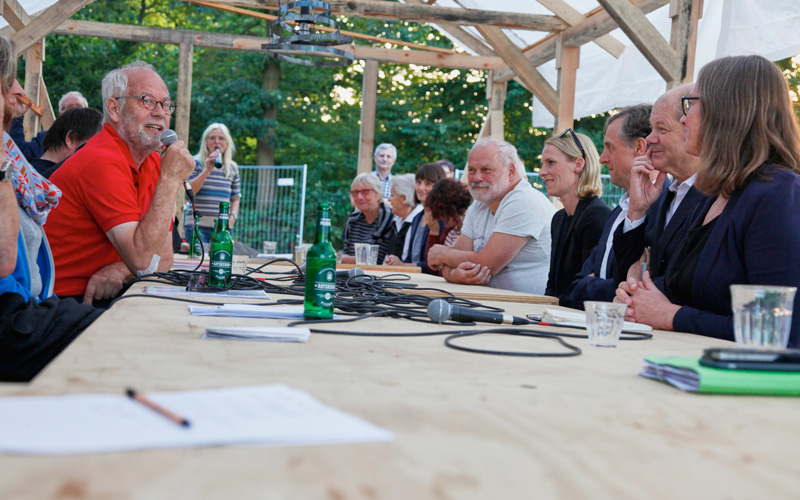
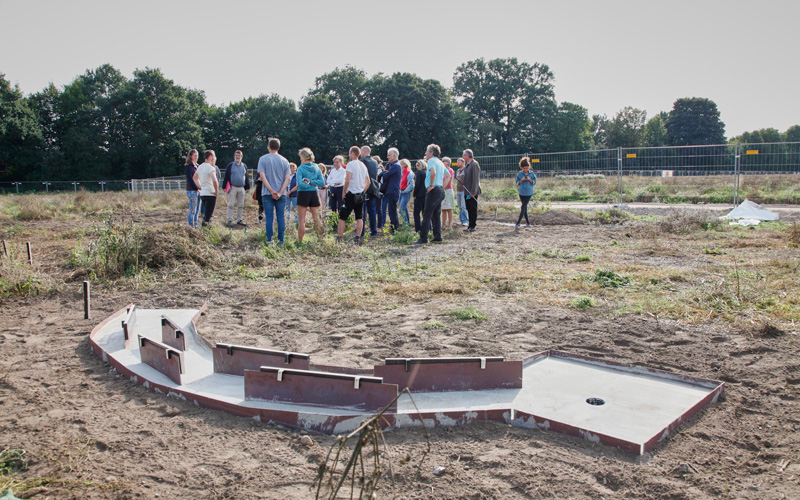
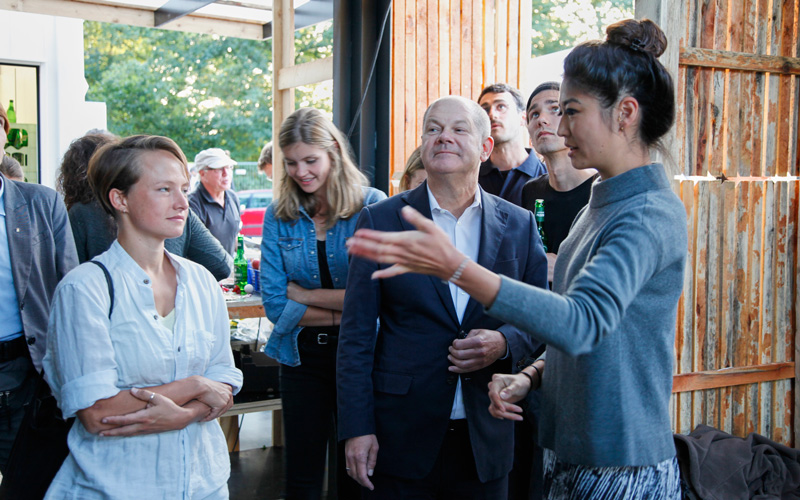
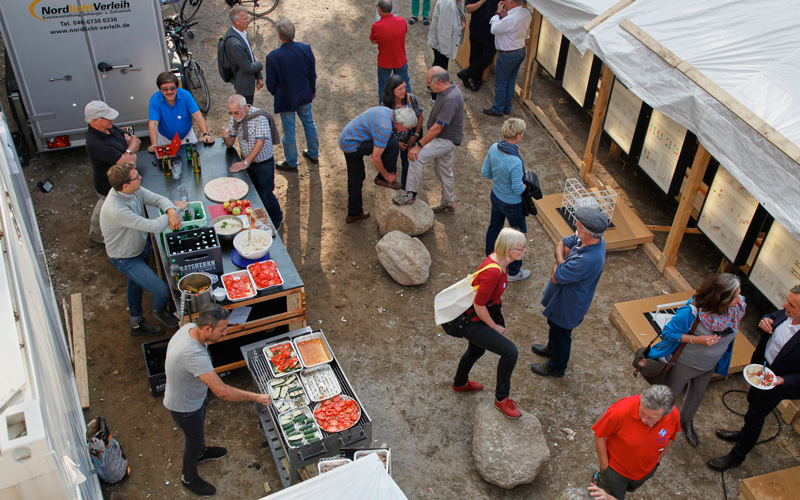
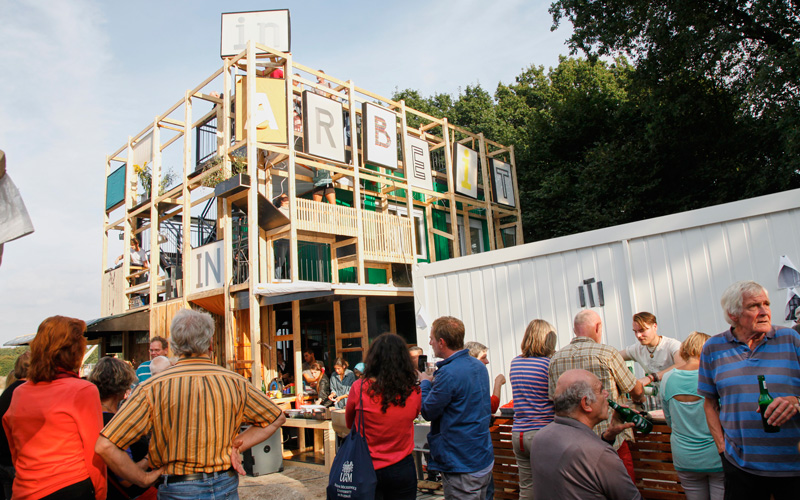





In a first draft of the summer school the closing day was conceived as the summer fest of the civil society initative Poppenbüttel hilft. The closer this event came, the more people participate in its planning. Here we would like to lay out the experimental arrangement of the closing day bit by bit, or let’s say project by project.
One of the most pertinent issues in the planning phase before the summers school was the process of deciding the modes of judging the outcomes of take 1 working on design-build proposals for the community building. This is where a competition was proposed. Doing competitions is quite common in the practice of architecture. A typical competition process looks like this: A selected group of architects gets a design brief (spatial programme), a duration and a budget to design a building. A jury comprised of stakeholders reviews all proposals and awards different prices and appreciations. The realisation process usually re-negotiates some aspects of the design proposal as an outcome of the necessity to meet regulations and budgets.
The initial design brief for the Community building Poppenbüttel from the civil society initiative said:
"The aim of the project building a house of gathering is to realize a one storey building in the eastern area of the site measuring 120 to 150 square meters in a self build process by inhabitants and supporters. The scheduling of all construction activities cannot be done before the availability of qualifications have been established. The utilisation concept ought to be discussed in the process of realisation, which makes it necessary to think a variety of possibilities to the building in its structure."
In order to stay true to the brief the project managers asked Doris Kleilein from the magazine Bauwelt to guide members of the jury through the display of the proposal designed in take 1 and focus on a set of aspects of design and the minimal structure to enable the realisation of the Community building as a design-build project rather than on a finalised form.
So the experimental arrangement for the function of the jury was transposed from being a selective and closing mode of judgement to a discursive mode that enables to discuss what judgement means and how it refers to criteria in the context of architecture as well as a political imaginary caused by the so called refugee crisis. Instead of presenting a range of predefined forms the competition becomes a machine in two ways: firstly for creating and refining questions. Secondly this framing sets and makes visible the conditions for any form to be developed from within the basic structures of the project.
The members of the jury were picked by the members of the civil society initiative and the research and teaching programme Urban Design. Amongst them were past, current and future stakeholders of the project. Of key importance was to approach the jury meeting in its doingness aspects. The jury meeting was framed as a guided tour. Doris Kleilein, head of the jury, guided all jury members through aspects from all three takes where the people who had worked on these aspects during the summer school gave brief presentations of the production process. This staging of the guided tour allowed all jury members to make up their minds about a heterogeneous set of aspects of the realization process of the community building, write them down and bring them up in the discussion in the round table – the main event of the closing days programme.
The support structure
This event was conceived as a setting in which the scales and scopes of the prototype and its futures could be discussed publicly. Summer school participants re-appropriated both the support structure and the roof over the dining tables as a display for visualisations of architectures and modes of future use. The support structure said »in Arbeit« (in progress) in big letters on illuminated displays. This claim addressed the projects motive of questioning and re-negotiating the process of realizing the project community building as a proposition for future modes of being active, such as learning on its construction site, earning new and proving already existing qualifications in the framework of German regulations and so on.
In the days before the Summer School members of Poppenbüttel hilft made a great effort to organize a visit by Hamburgs mayor Olaf Scholz, who already assumed the patronage for the building. It was not clear until the morning of the closing ceremony if he would be able to make it to the summer school due to a tight schedule and event in Berlin right before his potential visit. The project management team was given the information that he will arrive around 5 pm, 3 hours after the jury tour would take place.
Discussing the experimental arrangement for the closing day it was proposed by the members of Poppenbüttel hilft to give the mayor the commonly expected frame of attention and thereby creating a critical amount of acceptance for the project amongst all stakeholders and the general public. Members of the research and teaching programme Urban Design learned how members of the civil society initiative conceive their modes of communicating the project to the wider public in the form of a press article written by Peter Ulrich Meyer from Hamburger Abendblatt. Peter Ulrich Meyer was presented to members of the research and teaching programme Urban Design as the journalist read by all important and relevant people in politics in order to get an idea of what it means to live in Hamburg today. However, reading through the article it became clear that he did not get involved in the project as we’d hoped he would. The report appeared distant and aloof and was full of stereotypical wordings and images. Hence, this made us aware project management in Urban Design must address the scopic regimes in the process of planning and realizing the experimental arrangement of the closing ceremony.
Instead of welcoming the mayor according to the unspoken protocol proposed by the chairman of the civil society initiative, the participants of the summer school proposed to take the mayor for a tour and give him the same kind of insight as the jury members were enabled to hours before.
The question of display
Not as resume but as an outlook that re-evaluates the genealogy of the project and its discontents one could claim on the basis of the project archeology that the summer school is a discussion and elaboration on contemporary representations of the issues of Urban Design. The project archeology also demonstrates that while the summer school as project plays in a smaller scale, its relational setting implies much larger topics. One could argue that the project tackles its own articulation. Articulation here means the positioning of the project of the actors, actants and agencies as statement about a relationship to the city and thereby engaged in imaginaries that extend the architecture milieu. Saying this, we can also state the project archeology is a method to recapitulate the motivic structure of the project. In this sense the formulation of the project is also determined by the politics of its aesthetics. In this case the setting works not only in the closing event but in its totality as a display that comes about through materiality and spatial practice. Any differentiation between form and content or between means of display and the display are obsolete. This is the reason why we did the summer school in the first place: the motivic structure was not yet there in its refinement but in its raw structure. The practise of the summer school is a interventional mode of refining the motivic structure. Once again we refer to Ian Hackings description of scientific work: “We intervene to represent and we represent to intervene.” In this mode of work the projects iterative moment is located.
One has to keep in mind that in this context the term politics of aesthetics means that the project as display articulates and locates conceptual positions. But it never does so in the teleological sense but in creating a field or rather a stage for antagonism and contestation. It is important to note that the clash of spatial practice and the political imaginary of the refugee crisis is intended. While Rancière proposes that the political comes into functioning when two orders or two logics contest each other, we would say that the number of logics can be extended in number.
In practise this implies a consequence that also includes methodological aspects. The summer school needs a structure that can handle and propel the constructive confrontation of firstly a design strategy that bases itself on describing the urban situation as is, secondly a re-assembling of the political and administrative sector that is driven by the political imaginary of the refugee crisis and thirdly this political imaginary itself. Methodologically this is exemplified in the superimposition of three takes at the same site in the same time frame or in the round table at the closing ceremony that brings together different actors that represent and put forward different logics.
The project archeology indicates that the negotiation and the conflicts that are instigated and articulated here always include formal conflicts i.e. negotiations about open and closed form, about the hegemonic mode of tabula rasa planning and research on the potentialities of what is and its indeterminacies and contingencies. This conflict implies a dispute about visual orders and modes of rethoric of visuality. It reveals the display itself as a highly contested terrain.
What is the function of the closing ceremony?
The closing ceremony meanders in negotiation of a closing vs. an opening function. The celebration of working together for two weeks serves as a rite of passage. It is a mode of letting go, acknowledging what one has achieved and at the same time announces future activities. It serves as a positioning for framing the performative process of the summer school in two ways: A) As frame for the community and B) as frame for time.
Hacking, Ian. 1983. Representing and Intervening: Introductory Topics in the Philosophy of Natural Science. Cambridge, Mass, USA: Cambridge University Press.